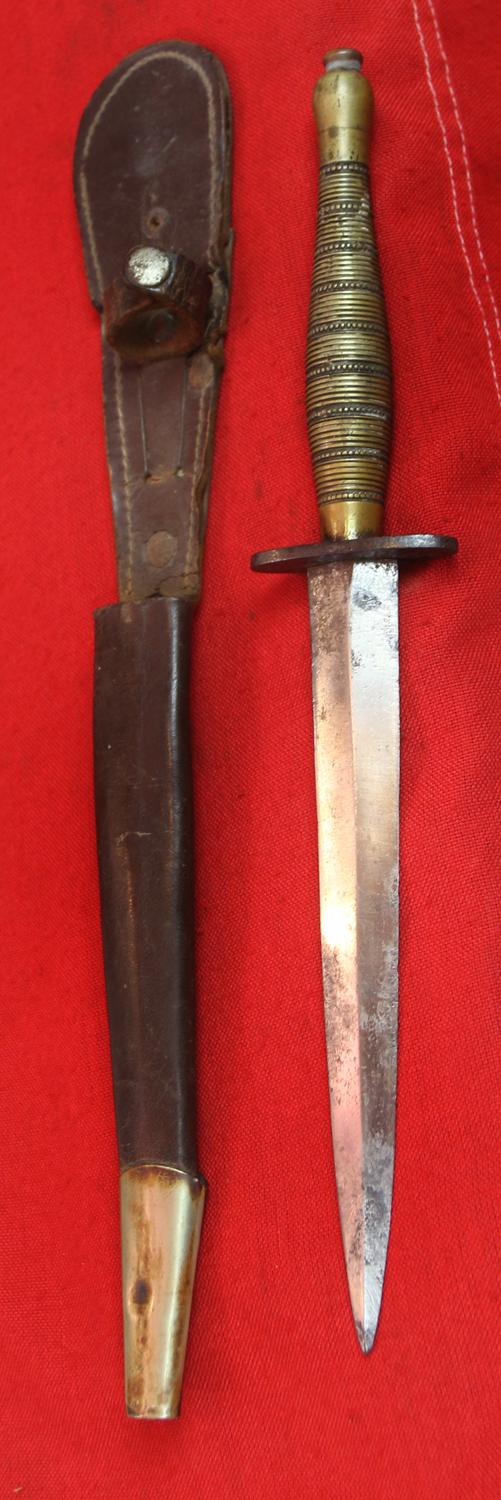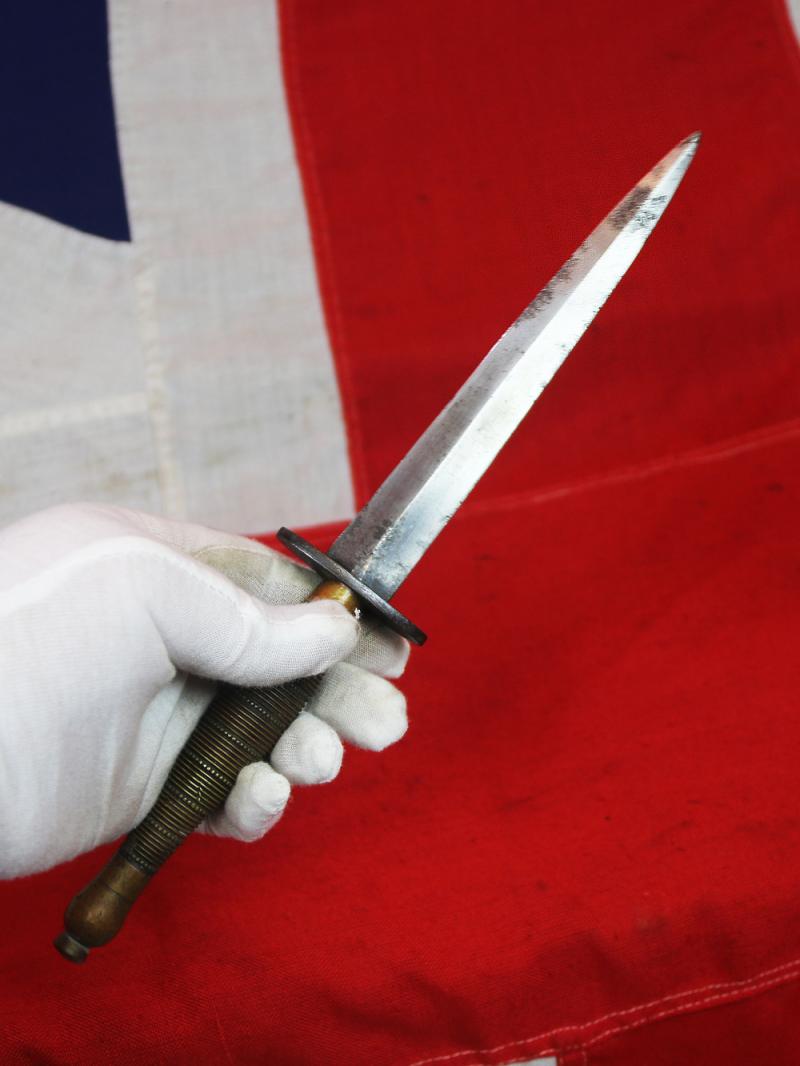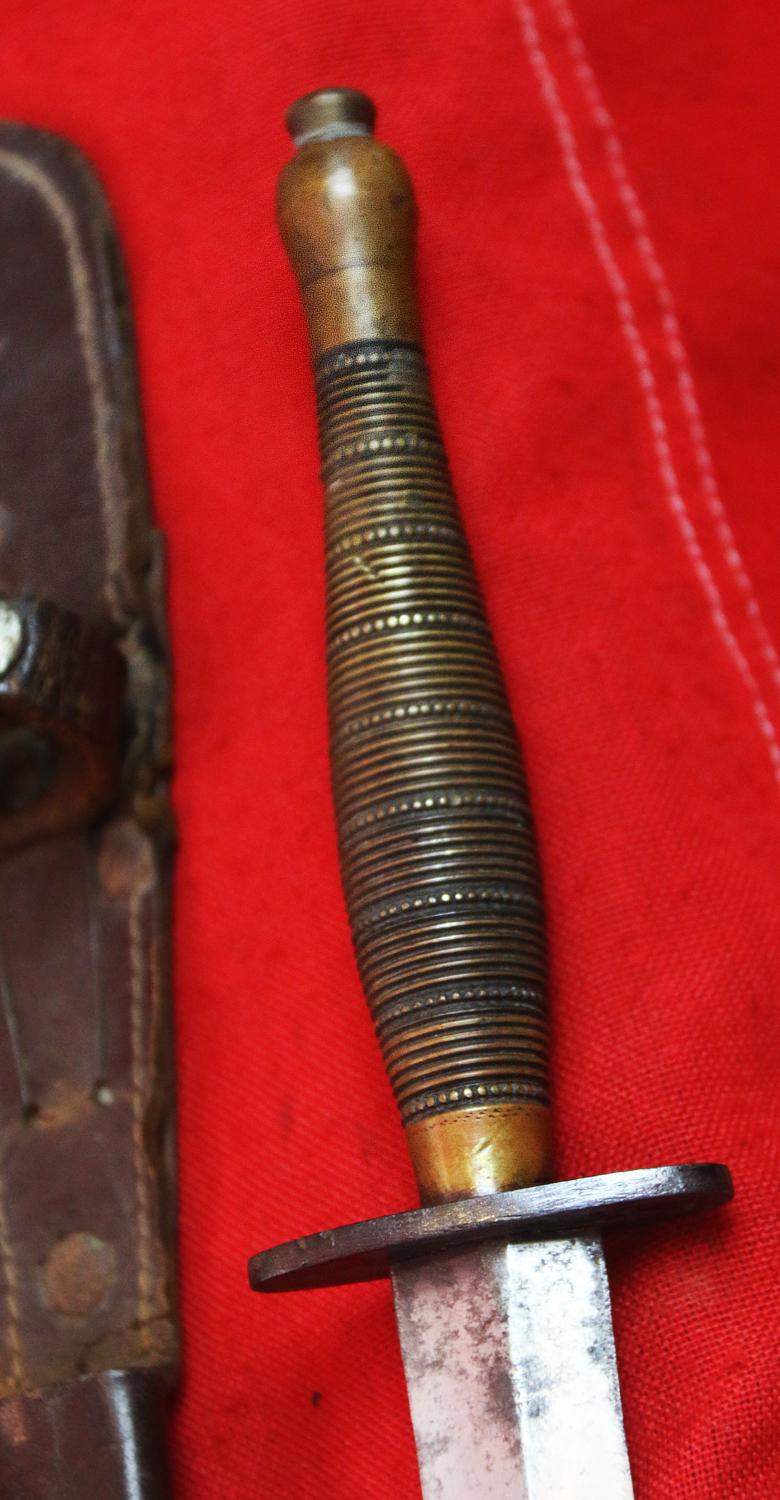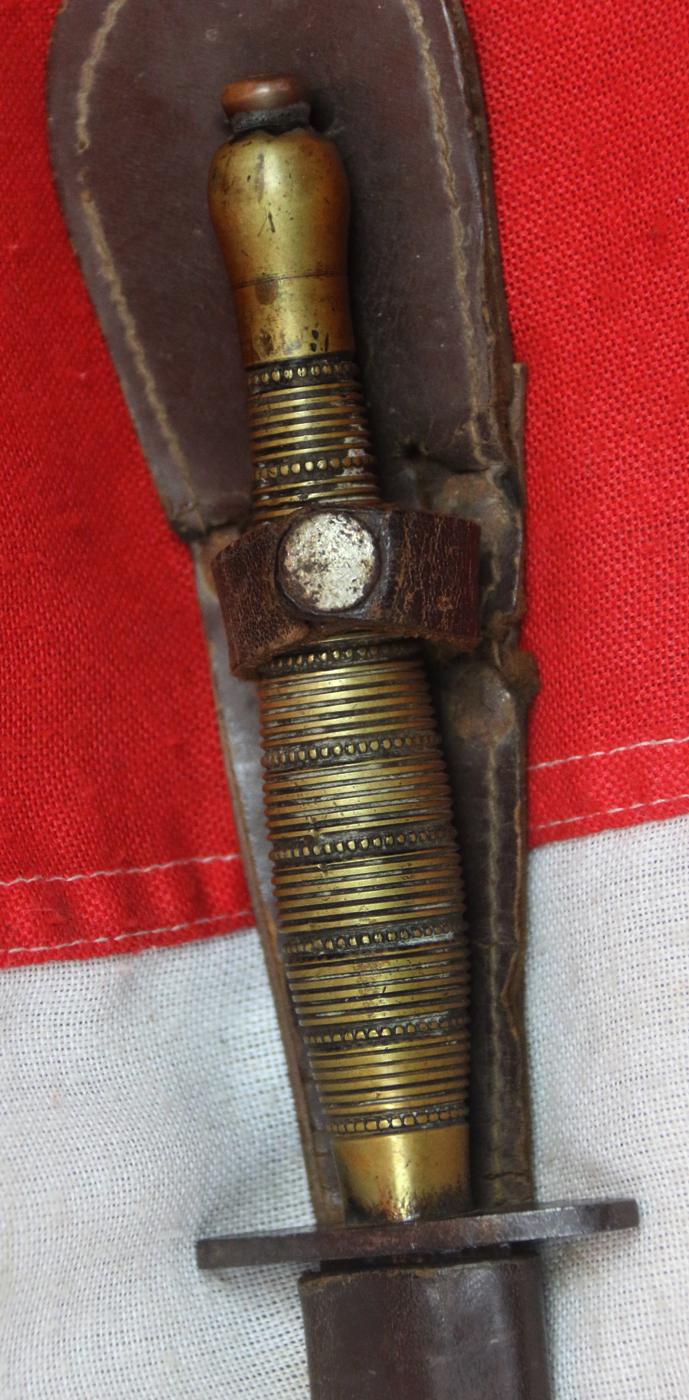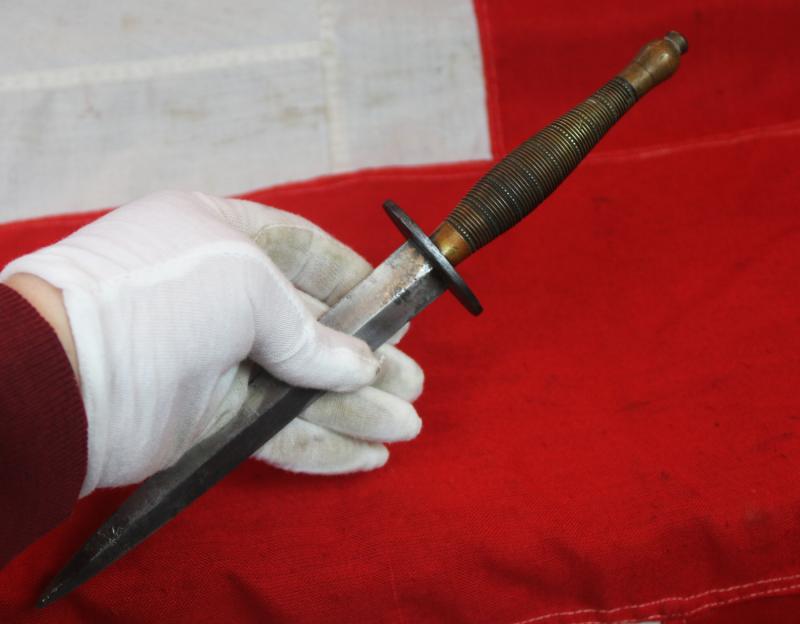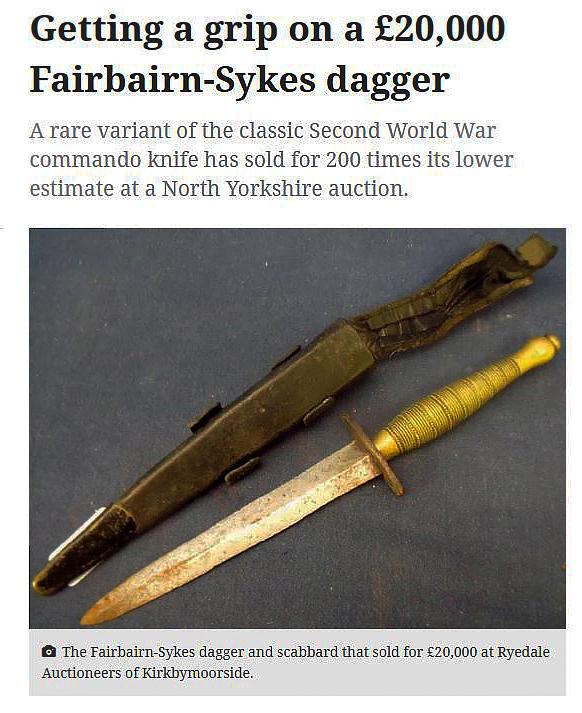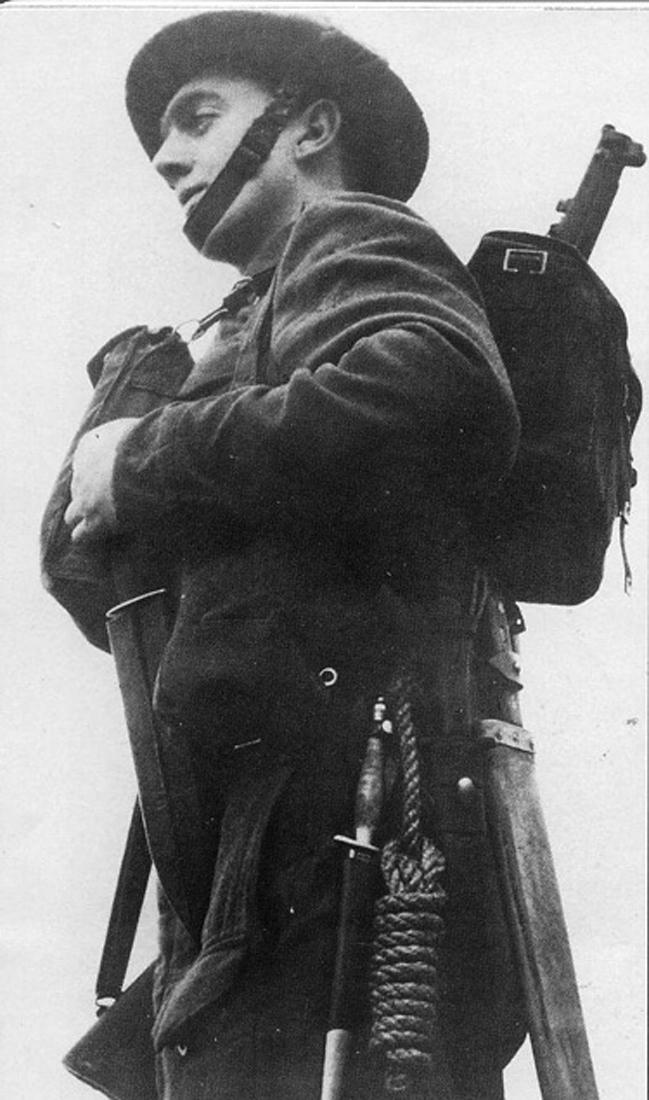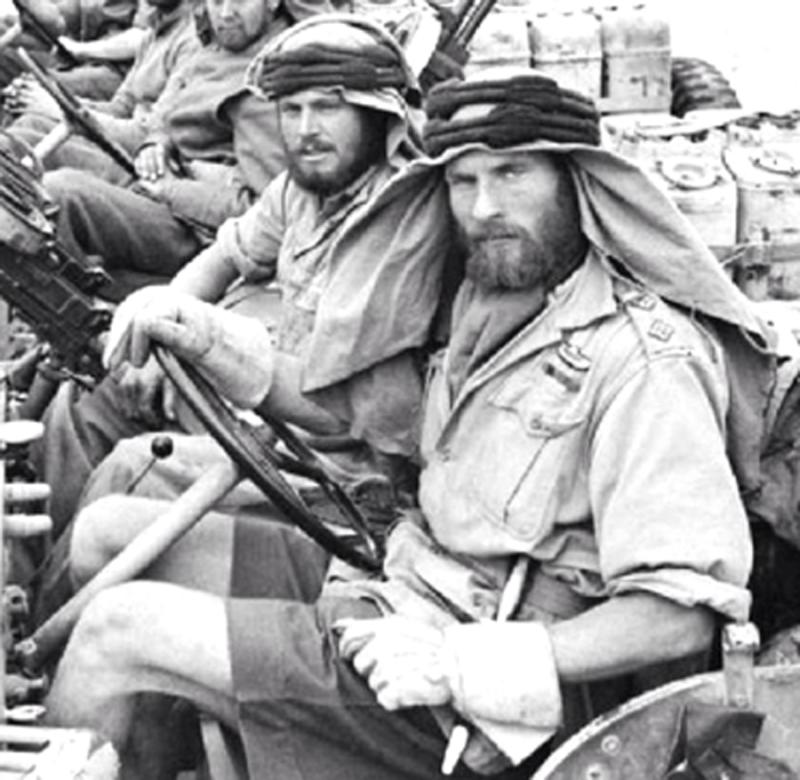A Cracking, Super Rare, Original FS Second Pattern British WW2 Commando Special Forces Dagger Rare Ribbed and 9 Row Beaded Grip Variant With Rare Hand Ground Blade
one of the most elegant of the variations on Second Pattern Knives, those referred to as Beaded and Ribbed. The handle turning has been often attributed to William Rodgers company.
Beaded & Ribbed versions have been found with 9,8,7 & 6 rows of beads (see page 127 of The Fairbairn Sykes Fighting Knife & Other Commando Knives by Ron Flook). This WW2 Beaded and Ribbed Pattern Fairbairn Sykes fighting knife has a brass beaded and ribbed grip with 9 rows of beads.
The F-S fighting knife, made famous when issued to British commandos, was produced in several patterns and many variants. This knife appears to be a subtle variation of the Second Pattern (made by more than 20 suppliers from c.1942) that is known to collectors at the ‘Ribbed & Beaded’ type on account of its distinctive and aesthetically pleasing grip.
To demonstrate just how collectable the rare 'ribbed and beaded' FS knife has become, in 2019, another example, but stamped 2, sold for an amazing £20,000 plus an additional £4,000 commission, for a net total of £24,000 gbp at Rydale Auctions in York. It wildly exceeded even the auctioneers expectations as it has little known exceptional history, but it certainly goes to show just how many sale records can be continually smashed by original rare collectables used by British WW2 special forces. Considered by many to be the most brave and skilled hand to hand combat soldiers in world armed forces history, an appraisal still universally, {and rightly}, agreed upon for the currently serving officers and men of Britain, Canada, Australia and New Zealand, within the same services. As are their American equivalents, apparently. However, for the sake of balance, the French Foreign Legion are none too shabby either. {Hello to Capt. J. F}
It is overall in lovely condition, for age and use and an example, that of its type, is very unlikely to be improved upon
An F.S. knife 2nd pattern variant, the so called by some 'Officers' type. The type that was made after the 1st pattern was discontinued from the 12th August 1942, until 1943. The story about the Fairbairn Sykes Fighting knife starts in England in 1940.
In 1940 the British formed special commandos to carry out raids. The initiative came from Winston Churchill in 1940 for a force that could carry out raids against German occupied Europe.. On the 8 June 1940, Section M09 of the War Office was brought into being. The name commando was taken from small effective mobile Boer units during the war in South Africa 1899-1902. Initially drawn from within the British Army from soldiers who volunteered for special service, the Commandos' ranks would eventually be filled by members of all branches of the United Kingdom's armed forces and a number of foreign volunteers from German-occupied countries.
Reaching a wartime strength of over 30 individual units and four assault brigades, the Commandos served in all theatres of war from the Arctic circle to Europe and from the Middle East to South-East Asia. Their operations ranged from small groups of men landing from the sea or by parachute to a brigade of assault troops spearheading the Allied invasions of Europe and Asia.
Two of the first instructors were Captain William Ewart Fairbairn (b. 28 February 1885, d. 20 June 1960) and Captain Eric Anthony Sykes (b. 5 February 1883, d. 12 May 1945). These middle aged gentlemen trained the young soldiers in a new and difficult mode of close-combat fighting at the Commando Basic Training Centre, Achnacarry, Scotland. Churchill described the commandos as 'a steel hand from the sea'
The need for a proper fighting knife, for these commandos, was apparent from the first few weeks of training specialized personnel. As Fairbairn later wrote, "…the authorities did not recognize a fighting knife as part of the equipment of the fighting services. In fact, such a thing as a fighting knife could not be purchased anywhere in Great Britain."
Until now, there had never been an official knife for the British armed services, although many types of knife had been authorised for use in the past. Bowie style knives were carried by some of the Imperial Yeomanry during the South African War of 1900-1901, and in World War I cut-down bayonets, privately purchased hunting knives, or captured German issue folding knives were extensively utilised.
In November 1940 there was a meeting between W. E. Fairbairn, E. A. Sykes and Robert Wilkinson Latham at Wilkinson Sword Company.
Fairbairn and Sykes described the type of knife they envisioned and the purpose for which it was intended. As discussion continued, preliminary sketches were drawn up and modified time and time again. As Robert Wilkinson Latham tells it: 'In order to explain exactly their point, the two men rose to their feet and one, it was Fairbairn my grandfather mentioned, grabbed the wood ruler from his desk and the two men danced around the office in mock combat'. W. E. Fairbairn had also brought with him an example of a suitable fighting knife.
The system they devised utilised techniques drawn from Jiu Jitsu, Gatka, Kung Fu and 'Gutter Fighting'. It proved extremely effective. They were natural choices for the job. Both had served in the Shanghai Municipal Police Force, facing death daily in the dark, narrow streets and alleys of the city against armed thugs and organised gangs. In Shanghai they had made some fighting knives out of bayonets. The meeting resulted in the Fairbairn Sykes Fighting Knife, that was manufactured, firstly, into the 1st pattern FS Knife, it was to then evolve, briefly, into the 2nd pattern FS Knife in August 1942 and eventually into the 3rd pattern, in around October 1943. The 3rd pattern is still in use today. This is very good example of these highly sought after early and rare 2nd types.
The knife is superb, obviously worn and used in combat but great otherwise, just a couple of old pit marks to the blade, and the hand ground blade is just shy of 7" inches long. The scabbard has had one field strengthening repair to the belt region
Code: 24709
Price
on
Request

